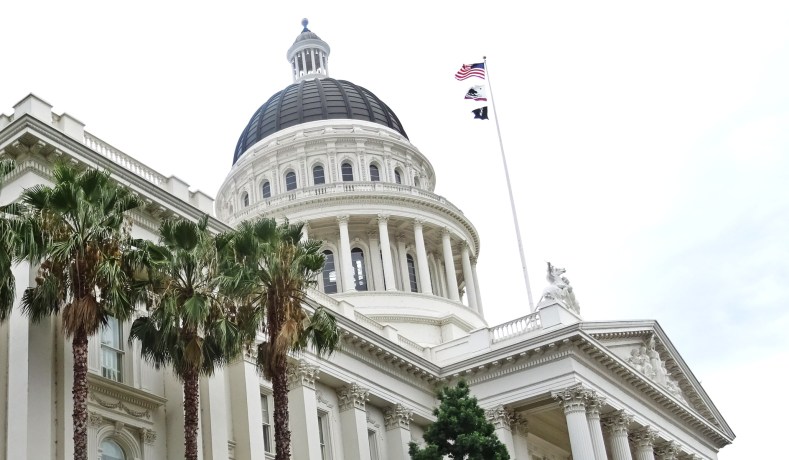Spoiler: "The least regulated state is South Dakota, with about 44,000 regulatory restrictions, while the most regulated state is California, with 395,000. All told, the least regulated states are South Dakota, Alaska, Montana, Idaho, and North Dakota, while the most regulated states are California, New York, Illinois, Ohio, and Texas."
https://www.nationalreview.com/2019/10/government-regulation-new-numerical-measure-ranks-states/
https://www.nationalreview.com/2019/10/government-regulation-new-numerical-measure-ranks-states/
Ranking the States by Regulation
By James Broughel
& Patrick A. McLaughlin October 17, 2019 6:30 AM

California State Capitol in Sacramento (Pixabay)
Information technology provides ways to measure numerically how much regulation each state has imposed.
Last week, President Trump signed two executive orders targeting unnecessary red tape, part of a broader effort in his administration to rein in excessive regulations. Early in his presidency, for example, Trump made headlines with a very ambitious claim that his administration would cut regulations by 75 percent. The statement may have been hyperbole — intended more to signal a desire to reduce burdens on business than an actual goal — but it nonetheless raises interesting questions. If an administration really did want to cut regulations by 75 percent, or even 10 or 20 percent, how would it go about doing that? How does one measure regulation?
For too long, regulations have escaped scrutiny because researchers and policymakers didn’t have good ways to measure them. Finally, that’s all beginning to change.
Economists have experimented with different regulation measures over the years: page counts, agency budgets, and the number of steps it takes to start a business have all been used. No metric is perfect, and each has its own advantages and drawbacks.
Since 2012, the Mercatus Center has been taking a different approach by using machine learning and text analysis to analyze the U.S. Code of Federal Regulations, part of a project we call RegData. Parsing legal text, RegData technology identifies restrictive terms such as “shall,” “must,” “may not,” “prohibited” and “required” (i.e., regulations).
The RegData software also uses machine-learning algorithms to map each restriction to the particular industries and sectors of the economy it is likely to affect. To date, RegData has been used in numerous peer-reviewed academic journal articles, casting light on the causes and effects of regulation in ways never before possible.
Now Mercatus has completed an analysis of state-level regulation. State RegData 1.0 analyzes the administrative codes of 46 states plus the District of Columbia, and the results are informative. The average state has 131,000 restrictive terms and about 9 million words in its code, which would require roughly twelve work weeks to read at a normal reading pace.
But there is huge variation. The least regulated state is South Dakota, with about 44,000 regulatory restrictions, while the most regulated state is California, with 395,000. All told, the least regulated states are South Dakota, Alaska, Montana, Idaho, and North Dakota, while the most regulated states are California, New York, Illinois, Ohio, and Texas.
Unfortunately, we weren’t able to include Vermont, New Jersey, Arkansas, and Hawaii. Arkansas is the easiest to explain: It has no administrative code, at least not yet. Its state agencies produce regulations, but until this year no one had ever bothered to compile them in one place. Fortunately — perhaps partly in response to RegData — legislation was passed this year to create an official Code of Arkansas Rules by January 2023, so Arkansas’s regulatory landscape will eventually come to light.
New Jersey and Vermont have administrative codes, and the codes are freely available online for anyone to read, but they are managed by LexisNexis, a private company whose terms and conditions prohibit downloading the text. We tried repeatedly to get permission to analyze these public documents — which requires downloading them first — but the company never returned our calls or emails.
Finally, Hawaii’s online code is simply too disorganized to analyze for now. Each agency’s rules are listed on a separate, unique website that would likely require writing a distinct computer program for each. Our hope is that these states will take action to make their codes more accessible to the public and to researchers in the future.
Despite missing a few states, we’ve learned a lot. For the most part, bigger, more populated states have more regulation. For example, many are surprised to learn that Texas is one of the most regulated states. Predictably, health and environmental regulations are among the dominant forms of state regulation — but in some cases, they’re joined by things like occupational-licensing regulations. And there is less regulation in some areas than one might expect. For example, non-health care-related insurance-industry regulation, which is primarily a state responsibility, seems to be relatively light.
With all this regulation on the books, it’s not surprising that many states are taking decisive action to streamline their codes, in some cases using RegData. In Missouri, former governor Eric Greitens set a one-third reduction target for agencies and used restriction counts to measure progress. Most recently, Idaho leaders claim to have cut more than 19,000 restrictions when the state’s old regulatory code expired on July 1. Expiration dates can be powerful tools for reducing regulatory burdens. Indeed, one of Trump’s executive orders last week gives agencies 120 days to review all the various guidance documents and policy memoranda they issue. Any mandates they want to keep will have to move into a new online database; everything else will expire.
These examples also highlight the importance of measurement when cutting red tape. President Trump’s goal of a 75 percent reduction may seem unrealistic, but other jurisdictions have cut regulatory requirements by as much as 50 percent without a dropoff in public health or safety. This leaves no question that large reductions in regulatory burdens are achievable so long as reformers have a clear measure of success. Now they finally have one.

